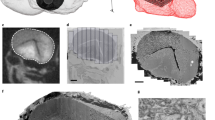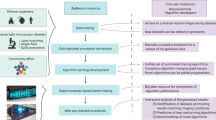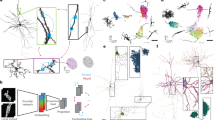Abstract
Comprehensive high-resolution structural maps are central to functional exploration and understanding in biology. For the nervous system, in which high resolution and large spatial extent are both needed, such maps are scarce as they challenge data acquisition and analysis capabilities. Here we present for the mouse inner plexiform layer—the main computational neuropil region in the mammalian retina—the dense reconstruction of 950 neurons and their mutual contacts. This was achieved by applying a combination of crowd-sourced manual annotation and machine-learning-based volume segmentation to serial block-face electron microscopy data. We characterize a new type of retinal bipolar interneuron and show that we can subdivide a known type based on connectivity. Circuit motifs that emerge from our data indicate a functional mechanism for a known cellular response in a ganglion cell that detects localized motion, and predict that another ganglion cell is motion sensitive.
This is a preview of subscription content, access via your institution
Access options
Subscribe to this journal
Receive 51 print issues and online access
$199.00 per year
only $3.90 per issue
Buy this article
- Purchase on Springer Link
- Instant access to full article PDF
Prices may be subject to local taxes which are calculated during checkout






Similar content being viewed by others
References
White, J. G., Southgate, E., Thomson, J. N. & Brenner, S. The structure of the nervous system of the nematode Caenorhabditis elegans. Phil. Trans. R. Soc. Lond. B 314, 1–340 (1986)
Varshney, L. R., Chen, B. L., Paniagua, E., Hall, D. H. & Chklovskii, D. B. Structural properties of the Caenorhabditis elegans neuronal network. PLOS Comput. Biol. 7, e1001066 (2011)
Binzegger, T., Douglas, R. J. & Martin, K. A. C. A quantitative map of the circuit of cat primary visual cortex. J. Neurosci. 24, 8441–8453 (2004)
Helmstaedter, M., de Kock, C. P., Feldmeyer, D., Bruno, R. M. & Sakmann, B. Reconstruction of an average cortical column in silico. Brain Res. Rev. 55, 193–203 (2007)
Briggman, K. L., Helmstaedter, M. & Denk, W. Wiring specificity in the direction-selectivity circuit of the retina. Nature 471, 183–188 (2011)
Stepanyants, A. & Chklovskii, D. B. Neurogeometry and potential synaptic connectivity. Trends Neurosci. 28, 387–394 (2005)
Mishchenko, Y. et al. Ultrastructural analysis of hippocampal neuropil from the connectomics perspective. Neuron 67, 1009–1020 (2010)
Hill, S. L., Wang, Y., Riachi, I., Schurmann, F. & Markram, H. Statistical connectivity provides a sufficient foundation for specific functional connectivity in neocortical neural microcircuits. Proc. Natl Acad. Sci. USA 109, E2885–E2894 (2012)
Denk, W., Briggman, K. L. & Helmstaedter, M. Structural neurobiology: missing link to a mechanistic understanding of neural computation. Nature Rev. Neurosci. 13, 351–358 (2012)
Peters, A. Thalamic input to the cerebral cortex. Trends Neurosci. 2, 183–185 (1979)
Markram, H., Lubke, J., Frotscher, M., Roth, A. & Sakmann, B. Physiology and anatomy of synaptic connections between thick tufted pyramidal neurones in the developing rat neocortex. J. Physiol. (Lond.) 500, 409–440 (1997)
Fried, S. I., Munch, T. A. & Werblin, F. S. Mechanisms and circuitry underlying directional selectivity in the retina. Nature 420, 411–414 (2002)
Asari, H. & Meister, M. Divergence of visual channels in the inner retina. Nature Neurosci. 15, 1581–1589 (2012)
Stevens, J. K., Davis, T. L., Friedman, N. & Sterling, P. A systematic approach to reconstructing microcircuitry by electron microscopy of serial sections. Brain Res. 2, 265–293 (1980)
Sterling, P. Microcircuitry of the cat retina. Annu. Rev. Neurosci. 6, 149–185 (1983)
Famiglietti, E. V. Synaptic organization of starburst amacrine cells in rabbit retina: analysis of serial thin sections by electron microscopy and graphic reconstruction. J. Comp. Neurol. 309, 40–70 (1991)
McGuire, B. A., Stevens, J. K. & Sterling, P. Microcircuitry of bipolar cells in cat retina. J. Neurosci. 4, 2920–2938 (1984)
Briggman, K. L. & Bock, D. D. Volume electron microscopy for neuronal circuit reconstruction. Curr. Opin. Neurobiol. 22, 154–161 (2012)
Masland, R. H. The neuronal organization of the retina. Neuron 76, 266–280 (2012)
Vaney, D. I., Sivyer, B. & Taylor, W. R. Direction selectivity in the retina: symmetry and asymmetry in structure and function. Nature Rev. Neurosci. 13, 194–208 (2012)
Euler, T., Detwiler, P. B. & Denk, W. Directionally selective calcium signals in dendrites of starburst amacrine cells. Nature 418, 845–852 (2002)
Zhou, Z. J. & Lee, S. Synaptic physiology of direction selectivity in the retina. J. Physiol. (Lond.) 586, 4371–4376 (2008)
Wei, W., Hamby, A. M., Zhou, K. & Feller, M. B. Development of asymmetric inhibition underlying direction selectivity in the retina. Nature 469, 402–406 (2011)
Denk, W. & Horstmann, H. Serial block-face scanning electron microscopy to reconstruct three-dimensional tissue nanostructure. PLoS Biol. 2, e329 (2004)
Helmstaedter, M., Briggman, K. L. & Denk, W. High-accuracy neurite reconstruction for high-throughput neuroanatomy. Nature Neurosci. 14, 1081–1088 (2011)
Jain, V. et al. Supervised learning of image restoration with convolutional networks. IEEE 11th International Conference on Computer Vision 2, 1–8 (2007)
Turaga, S. C. et al. Convolutional networks can learn to generate affinity graphs for image segmentation. Neural Comput. 22, 511–538 (2010)
Wässle, H., Puller, C., Muller, F. & Haverkamp, S. Cone contacts, mosaics, and territories of bipolar cells in the mouse retina. J. Neurosci. 29, 106–117 (2009)
Amthor, F. R., Oyster, C. W. & Takahashi, E. S. Morphology of on-off direction-selective ganglion cells in the rabbit retina. Brain Res. 298, 187–190 (1984)
Strettoi, E., Raviola, E. & Dacheux, R. F. Synaptic connections of the narrow-field, bistratified rod amacrine cell (AII) in the rabbit retina. J. Comp. Neurol. 325, 152–168 (1992)
Macneil, M. A., Heussy, J. K., Dacheux, R. F., Raviola, E. & Masland, R. H. The shapes and numbers of amacrine cells: matching of photofilled with Golgi-stained cells in the rabbit retina and comparison with other mammalian species. J. Comp. Neurol. 413, 305–326 (1999)
Fyk-Kolodziej, B. & Pourcho, R. G. Differential distribution of hyperpolarization-activated and cyclic nucleotide-gated channels in cone bipolar cells of the rat retina. J. Comp. Neurol. 501, 891–903 (2007)
Wassle, H. & Riemann, H. J. Mosaic of nerve-cells in mammalian retina. Proc. R. Soc. Lond. B 200, 441–461 (1978)
Kim, I. J., Zhang, Y., Meister, M. & Sanes, J. R. Laminar restriction of retinal ganglion cell dendrites and axons: subtype-specific developmental patterns revealed with transgenic markers. J. Neurosci. 30, 1452–1462 (2010)
Levick, W. R. Receptive fields and trigger features of ganglion cells in the visual streak of the rabbits retina. J. Physiol. (Lond.) 188, 285–307 (1967)
Amthor, F. R., Takahashi, E. S. & Oyster, C. W. Morphologies of rabbit retinal ganglion cells with complex receptive fields. J. Comp. Neurol. 280, 97–121 (1989)
Kolb, H., Nelson, R. & Mariani, A. Amacrine cells, bipolar cells and ganglion cells of the cat retina: a Golgi study. Vision Res. 21, 1081–1114 (1981)
Sivyer, B., Venkataramani, S., Taylor, W. R. & Vaney, D. I. A novel type of complex ganglion cell in rabbit retina. J. Comp. Neurol. 519, 3128–3138 (2011)
Siegert, S. et al. Genetic address book for retinal cell types. Nature Neurosci. 12, 1197–1204 (2009)
Badea, T. C. & Nathans, J. Quantitative analysis of neuronal morphologies in the mouse retina visualized by using a genetically directed reporter. J. Comp. Neurol. 480, 331–351 (2004)
Joo, H. R., Peterson, B. B., Haun, T. J. & Dacey, D. M. Characterization of a novel large-field cone bipolar cell type in the primate retina: evidence for selective cone connections. Vis. Neurosci. 28, 29–37 (2011)
Seung, H. S. Reading the book of memory: sparse sampling versus dense mapping of connectomes. Neuron 62, 17–29 (2009)
Masland, R. H. The fundamental plan of the retina. Nature Neurosci. 4, 877–886 (2001)
Andres, B. et al. in Computer Vision – ECCV 2012 Lecture Notes in Computer Science (eds Fitzgibbon, A. et al.) 778–791 (Springer, 2012)
Tsukamoto, Y., Morigiwa, K., Ueda, M. & Sterling, P. Microcircuits for night vision in mouse retina. J. Neurosci. 21, 8616–8623 (2001)
Calkins, D. J. & Sterling, P. Microcircuitry for two types of achromatic ganglion cell in primate fovea. J. Neurosci. 27, 2646–2653 (2007)
Zhang, Y., Kim, I. J., Sanes, J. R. & Meister, M. The most numerous ganglion cell type of the mouse retina is a selective feature detector. Proc. Natl Acad. Sci. USA 109, E2391–E2398 (2012)
Ölveczky, B. P., Baccus, S. A. & Meister, M. Segregation of object and background motion in the retina. Nature 423, 401–408 (2003)
Turaga, S. C., Briggman, K., Helmstaedter, M., Denk, W. & Seung, H. S. Maximin affinity learning of image segmentation. Adv. Neural Info. Proc. Syst. 22, 1–8 (2009)
Studer, D. & Gnaegi, H. Minimal compression of ultrathin sections with use of an oscillating diamond knife. J. Microsc. 197, 94–100 (2000)
Binding, J., Mikula, S. & Denk, W. Low-dosage maximum-a-posteriori focusing and stigmation. Microsc. Microanal. 19, 38–55 (2013)
Acknowledgements
We thank J. Diamond, T. Euler, R. Masland, M. Meister and J. Sanes for discussions, J. Kornfeld and F. Svara for programming and continually improving KNOSSOS, M. Müller and J. Tritthardt for programming and building instrumentation, C. Roome for IT support, and A. Borst, M. Fee, T. Gollisch and A. Karpova for comments on the manuscript. We especially thank F. Isensee for help with synapse identification. We thank P. Bastians, A. Biasotto, F. Drawitsch, H. Falk, A. Gable, M. Grohmann, A. Gäbelein, J. Hanne, F. Isensee, H. Jakobi, M. Kotchourko, E. Möller, J. Pollmann, C. Röhrig, A. Rommerskirchen, L. Schreiber, C. Willburger, H. Wissler and J. Youm for reconstruction management and annotator training, and N. Abazova, S. Abele, O. Aderhold, C. Altbürger, T. Amberger, K. Aninditha, A. Antunes, E. Atsiatorme, H. Augenstein, I. Bartsch, I. Barz, P. Bastians, J. Bauer, H. Bauersachs, R. Bay, J. Becker, M. Beez, S. Bender, M. Berberich, I. Bertlich, J. Bewersdorf, A. Biasotto, P. Biti, M. Bittmann, K. Bretzel, J. Briegel, E. Buckler, A. Buntjer, C. Burkhardt, S. Bühler, S. Daum, N. Demir, E. Demirel, S. Dettmer, M. Diemer, J. Dietrich, S. Dittrich, C. Domnick, F. Drawitsch, C. Eck, L. Ehm, S. Ehrhardt, T. Eliguezel, K. Ernst, O. Eryilmaz, F. Euler, H. Falk, K. Fischer, K. Foerster, R. Foitzik, A. Foltin, R. Foltin, S. Freiß, A. Gable, P. Gallandi, K. Garbe, A. Gebhardt, F. Gebhart, S. Gottwalt, A. Greis, M. Grohmann, A. Gromann, S. Gröbner, E. Grün, M. Grün, K. Guo, A. Gäbelein, K. Haase, J. Hammerich, J. Hanne, B. Hauber, M. Hensen, F. Hentzschel, M. Herberz, M. Heumannskämper, C. Hilbert, L. Hofmann, P. Hofmann, T. Hondrich, U. Häusler, M. Höreth, J. Hügle, F. Isensee, A. Ivanova, F. Jahnke, H. Jakobi, M. Joel, M. Jonczyk, A. Joschko, A. Jünger, K. Kappler, S. Kaspar, C. Kehrel, J. Kern, K. Keßler, S. Khoury, M. Kiapes, M. Kirchberger, A. Klein, C. Klein, S. Klein, J. Kratzer, C. Kraut, P. Kremer, P. Kretzer, F. Kröller, D. Krüger, M. Kuderer, S. Kull, S. Kwakman, S. Laiouar, L. Lebelt, H. Lesch, R. Lichtenberger, J. Liermann, C. Lieven, J. Lin, B. Linser, S. Lorger, J. Lott, D. Luft, L. Lust, J. Löffler, C. Marschall, B. Martin, D. Maton, B. Mayer, S. Mayorca, de. Ituarte, M. Meleux, C. Meyer, M. Moll, T. Moll, L. Mroszewski, E. Möller, M. Müller, L. Münster, N. Nasresfahani, J. Nassal, M. Neuschwanger, C. Nguyen, J. Nguyen, N. Nitsche, S. Oberrauch, F. Obitz, D. Ollech, C. Orlik, T. Otolski, S. Oumohand, A. Palfi, J. Pesch, M. Pfarr, S. Pfarr, M. Pohrath, J. Pollmann, M. Prokscha, S. Putzke, E. Rachmad, M. Reichert, J. Reinhardt, M. Reitz, J. Remus, M. Richter, M. Richter, J. Ricken, N. Rieger, F. Rodriguez. Jahnke, A. Rommerskirchen, M. Roth, I. Rummer, J. Rätzer, C. Röhrig, J. Röther, V. Saratov, E. Sauter, T. Schackel, M. Schamberger, M. Scheller, J. Schied, M. Schiedeck, J. Schiele, K. Schleich, M. Schlösser, S. Schmidt, C. Schneeweis, K. Schramm, M. Schramm, L. Schreiber, D. Schwarz, A. Schürholz, L. Schütz, A. Seitz, C. Sellmann, E. Serger, J. Sieber, L. Silbermann, I. Sonntag, T. Speck, Y. Söhngen, T. Tannig, N. Tisch, V. Tran, J. Trendel, M. Uhrig, D. Vecsei, F. Viehweger, V. Viehweger, R. Vogel, A. Vogel, J. Volz, P. Weber, K. Wegmeyer, J. Wiederspohn, E. Wiegand, R. Wiggers, C. Willburger, H. Wissler, V. Wissdorf, S. Wörner, J. Youm, A. Zegarra, J. Zeilfelder, F. Zickgraf and T. Ziegler for cell reconstruction. This work was supported by the Max-Planck Society and the DFG (Leibniz prize to W.D.). H.S.S. is grateful for support from the Gatsby Charitable Foundation.
Author information
Authors and Affiliations
Contributions
M.H. and W.D. designed the study. K.L.B. prepared the samples and acquired the data using a microtome designed by W.D. M.H. analysed the data, with minor contributions from W.D. S.C.T., V.J. and H.S.S. developed the boundary classifier. M.H., K.L.B. and W.D. wrote the paper.
Corresponding author
Ethics declarations
Competing interests
W.D. receives licensing income from Gatan Inc.
Supplementary information
Supplementary Information
This file contains full descriptions of Supplementary Data sets 1-8. (PDF 523 kb)
Supplementary Data
This file contains Supplementary Data 1, a gallery of cell types, depth profiles, and contact area plots (see Supplementary Information for detailed description). (PDF 27686 kb)
Supplementary Data
This zipped file contains Supplementary Data files 2, 4, 5, 7 and 8 (see Supplementary Information for detailed description). (ZIP 26213 kb)
Supplementary Data
This zipped file contains Supplementary Data files 3a and b, which contain volume data samples from the conventionally stained sample (see Supplementary Information for detailed description). (ZIP 27921 kb)
Supplementary Data
This zipped file contains Supplementary Data files 3c, d and e containing volume data samples of EM data from the main data set (e2006), X-direction component of the classifier output for the same region, and segmentation before skeleton-based object collection (see Supplementary Information for detailed description). (ZIP 27295 kb)
Supplementary Data
This zipped file contains Supplementary Data 6 a and b, 6a contains a gallery of 36 Ganglion cells, 6b contains Gallery of 190 small-field Amacrine cells (see Supplementary Information for detailed description). (ZIP 22023 kb)
Supplementary Data
This zipped file contains Supplementary Data 6c, which contains a gallery of 163 medium- and wide-field Amacrine cells (see Supplementary Information for detailed description). (ZIP 16569 kb)
Supplementary Data
This zipped file contains Supplementary Data 6d which contains a gallery of 307 cone bipolar cells (see Supplementary Information for detailed description). (ZIP 26832 kb)
Supplementary Data
This zipped file contains Supplementary Data 6e and f, 6e contains a gallery of 144 rod bipolar cells and 6f contains a gallery of 110 cells from the “orphan” category (see Supplementary Information for detailed description). (ZIP 21656 kb)
Rights and permissions
About this article
Cite this article
Helmstaedter, M., Briggman, K., Turaga, S. et al. Connectomic reconstruction of the inner plexiform layer in the mouse retina. Nature 500, 168–174 (2013). https://doi.org/10.1038/nature12346
Received:
Accepted:
Published:
Issue Date:
DOI: https://doi.org/10.1038/nature12346
This article is cited by
-
Subcellular pathways through VGluT3-expressing mouse amacrine cells provide locally tuned object-motion-selective signals in the retina
Nature Communications (2024)
-
A presynaptic source drives differing levels of surround suppression in two mouse retinal ganglion cell types
Nature Communications (2024)
-
Distributed feature representations of natural stimuli across parallel retinal pathways
Nature Communications (2024)
-
RoboEM: automated 3D flight tracing for synaptic-resolution connectomics
Nature Methods (2024)
-
Dendritic mGluR2 and perisomatic Kv3 signaling regulate dendritic computation of mouse starburst amacrine cells
Nature Communications (2024)
Comments
By submitting a comment you agree to abide by our Terms and Community Guidelines. If you find something abusive or that does not comply with our terms or guidelines please flag it as inappropriate.



